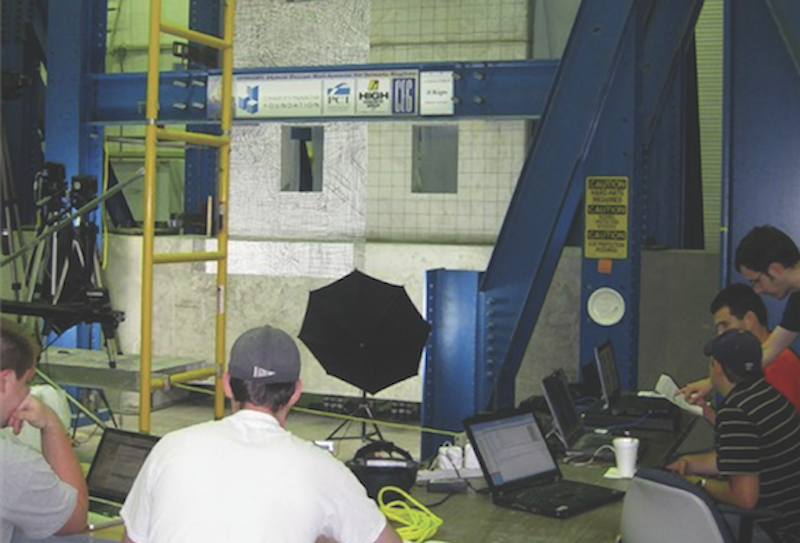In 2002, a couple of years before he died, Charles J. Pankow, Founder and Chairman of design-build firm Charles Pankow Builders, established a research foundation in his name. A pioneer in concrete-forming and moment-framing technology, Pankow was frustrated with the U.S. construction industry’s paltry support of research—a tiny fraction of 1% of revenues, compared to 11.1% of revenue for R&D in the health sector and 4.0% in the automotive, according to PwC’s 2015 Global Innovation 1000 report.
The biggest stumbling block to innovation in construction was (and is) lack of risk capital, due to sub-2% profit margins, says Richard “Rik” Kunnath, PE, Board President of the Charles Pankow Foundation (CPF). Add widespread reluctance among contractors to try anything new, coupled with the fragmentation of the AEC industry, and investing in R&D historically got short shrift.
The CPF wasn’t fettered by those restrictions. “As a nonprofit foundation, we could take risks that others could not,” says Kunnath. In 2006, the foundation started issuing grants, mostly to civil engineering profs at U.S. universities.
Results were mixed. Some of the research did lead to a few code tweaks and design improvements, but there were no breakthroughs. “We were washing the cleanest shirt in the laundry,” Kunnath admits. The foundation needed to concentrate its scarce resources where it could have the greatest impact.
Four years ago, Kunnath and Executive Director Mark J. Perniconi, PE, convened an advisory panel to identify where CPF-sponsored research could have the biggest bang for the buck.
Out of this strategic review came eight R&D initiatives that CPF would focus on (see list at left). It was a rigorous agenda, one that was very much in keeping with Charlie Pankow’s original intent: to cultivate innovation in design and construction and thereby “create buildings of improved quality, efficiency, and value.”
At the same time, the CPF board realized it could not change the AEC world on its own. It needed financial support from others. In recent years, the foundation has partnered with such entities as the ACI Foundation, the American Institute of Steel Construction (AISC), the Construction Industry Institute, the American Society of Concrete Contractors, and AEC firms Clark Construction Group, Magnusson Klemencic Associates, and Skanska USA Building.
Last year, CPF teamed up with 17 co-funders, whose investments leveraged its grant-making capability by 40-50%, says Kunnath. It was CPF’s biggest year ever: more than $2 million in grants. Let’s take a look at a few such efforts.
helping to MAKe INROADS ON BIM INTEROPERABILITY
CPF’s biggest investment—about $4 million—has been in BIM interoperability. “The SEs have their BIM software, the GCs have theirs, and the programs don’t speak to each other,” says Kunnath. CPF is supporting research at Georgia Tech to develop “translator codes” that will let the various BIM programs to talk to each other.
Out of that research came CPF’s Owners’ Guide to BIM Utilization. “It gives owners a good understanding of where BIM works, when to use it, at what level of detail,” says Kunnath. The guide has been adopted by the U.S. Army Corps of Engineers and others.
CPF has also supported BIM-M, a five-year program to encourage BIM use in masonry. It started when members of the Mason Contractors Association of America said they were being asked to bid projects using BIM. “Most had no idea how to do it,” says David Biggs, PE, SE, BIM-M Program Coordinator. “The steel and concrete people were well ahead of us in BIM.”
By the time the program sunsets next year, BIM-M will have invested about $2.2 million in R&D and BIM education for masons. “We’re supporting the development of plug-ins to make existing BIM software from Tekla and other vendors more useful to mason contractors,” says Biggs.
ENABLING STEEL AND CONCRETE R&D
Aiding research to make high-strength steel rebar a reality in the U.S. has been a major initiative. “U.S. codes don’t allow steel above 60 ksi, while the rest of the world is using 100 ksi steel,” says Kunnath. The HSS steel effort will take a decade and cost $10-15 million, but “in the end, we will have moved the U.S. into the modern era to make buildings cheaper and more globally competitive.”
CPF is partnering with AISC on concrete-filled composite plate shear walls. The three-year, $600,000 project (split evenly by CPF and AISC) will generate experimental data and numerical models leading to design guidelines for CF-CPSW core walls.
The research is being headed by Amit Varma at Purdue University. If successful, it would allow such core walls to be erected four stories at a time, using anchors and studs, with no rebar. AISC Vice President Lawrence F. Knuth, PE, says FEMA is adding $150,000 to the pot to test whether CF-CPSW walls could yield an R-value of R-8 for concrete (currently, R-6).
"We needed a new strategy. we were washing the cleanest shirt in the laundry."
Rik kunnath, PE, Charles Pankow Foundation
CPF is not alone in sponsoring AEC-related research. A number of architecture giants—Gensler, Perkins+Will, Perkins Eastman, CallisonRTKL, and GBBN, among others—routinely conduct research related to their work.
The AIA’s Academy for Architecture in Health Foundation has given $200,000 toward research in the last four years, notably for designing improved patient flow in emergency departments.
But the true catalyst for change in the construction sector has been the Charles Pankow Foundation. Since 2006, it has funded more than $12 million in research. The foundation recently pulled together a panel of 10 experts to codify best practices for high-rise construction in earthquake zones.
That initiative resulted in “Guidelines for Performance-based Design of Tall Buildings,” which details a peer-reviewed, rather than prescriptive, path for building in seismic zones.
THERE’S MORE TO COME
The foundation has been partnering with the Concrete Reinforcing Steel Institute on a multi-year project to gain industry consensus on performance specifications for high-strength rebar in seismic applications—data that will be used in modifications to the 2019 version of the ACI 318 building code.
The research is being conducted at multiple universities—Kansas and UT Austin among them—with technical help and materials donations in the $2-4 million range from steel mills and fabs.
“Having the partnership is crucial to getting all this research into practice,” says David McDonald, PhD, PE, FACI, the CRSI’s CEO.
“Research into practice.” That’s what the Charles Pankow Foundation is all about.
Related Stories
Resiliency | Jun 14, 2023
HUD offers $4.8 billion in funding for green and resilient building retrofit projects
The Department of Housing and Urban Development (HUD) recently released guidelines for its Green and Resilient Retrofit Program (GRRP) that has $4.8 billion for funding green projects.
Arenas | Jun 14, 2023
A multipurpose arena helps revitalize a historic African American community in Georgia
In Savannah, Ga., Enmarket Arena, a multipurpose arena that opened last year, has helped revitalize the city’s historic Canal District—home to a largely African American community that has been historically separated from the rest of downtown.
Building Materials | Jun 14, 2023
Construction input prices fall 0.6% in May 2023
Construction input prices fell 0.6% in May compared to the previous month, according to an Associated Builders and Contractors analysis of the U.S. Bureau of Labor Statistics’ Producer Price Index data released today. Nonresidential construction input prices declined 0.5% for the month.
Contractors | Jun 13, 2023
The average U.S. contractor has 8.9 months worth of construction work in the pipeline, as of May 2023
Associated Builders and Contractors reported that its Construction Backlog Indicator remained unchanged at 8.9 months in May, according to an ABC member survey conducted May 20 to June 7. The reading is 0.1 months lower than in May 2022. Backlog in the infrastructure category ticked up again and has now returned to May 2022 levels. On a regional basis, backlog increased in every region but the Northeast.
Mass Timber | Jun 13, 2023
Mass timber construction featured in two-story mixed-use art gallery and wine bar in Silicon Valley
The Edes Building, a two-story art gallery and wine bar in the Silicon Valley community of Morgan Hill, will prominently feature mass timber. Cross-laminated timber (CLT) and glulam posts and beams were specified for aesthetics, biophilic properties, and a reduced carbon footprint compared to concrete and steel alternatives.
Industry Research | Jun 13, 2023
Two new surveys track how the construction industry, in the U.S. and globally, is navigating market disruption and volatility
The surveys, conducted by XYZ Reality and KPMG International, found greater willingness to embrace technology, workplace diversity, and ESG precepts.
Mixed-Use | Jun 12, 2023
Goettsch Partners completes its largest China project to date: a mixed-used, five-tower complex
Chicago-based global architecture firm Goettsch Partners (GP) recently announced the completion of its largest project in China to date: the China Resources Qianhai Center, a mixed-use complex in the Qianhai district of Shenzhen. Developed by CR Land, the project includes five towers totaling almost 472,000 square meters (4.6 million sf).
University Buildings | Jun 9, 2023
Cornell’s new information science building will foster dynamic exchange of ideas and quiet, focused research
Construction recently began on Cornell University’s new 135,000-sf building for the Cornell Ann S. Bowers College of Computing and Information Science (Cornell Bowers CIS). The structure will bring together the departments of Computer Science, Information Science, and Statistics and Data Science for the first time in one complex.
Museums | Jun 6, 2023
New wing of Natural History Museums of Los Angeles to be a destination and portal
NHM Commons, a new wing and community hub under construction at The Natural History Museums (NHM) of Los Angeles County, was designed to be both a destination and a portal into the building and to the surrounding grounds.
Codes and Standards | Jun 6, 2023
California’s new power grid modernization plan furthers ambitious climate goals
California’s new $7.3 billion grid modernization plan is a crucial step in furthering its ambitious climate goals. The board of governors for the California Independent System Operator (CAISO), the state’s grid operator, recently approved a strategy to build thousands of miles of new high-voltage transmission lines.

















